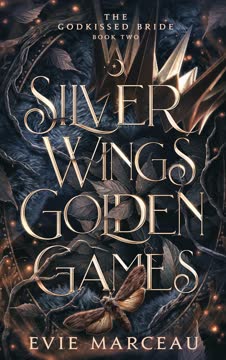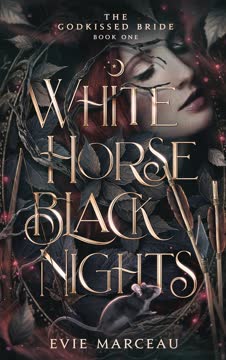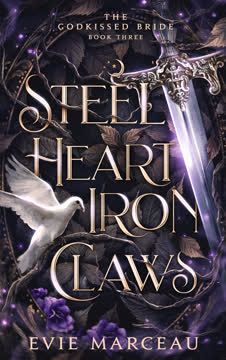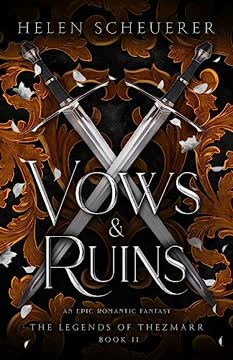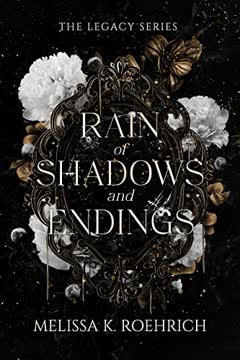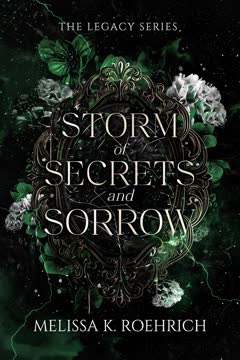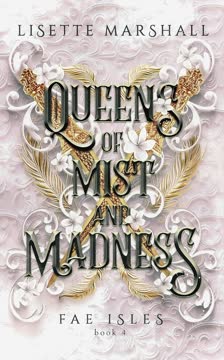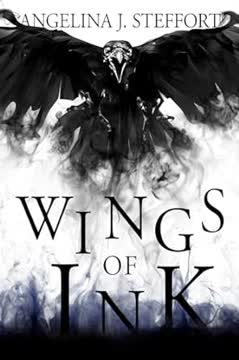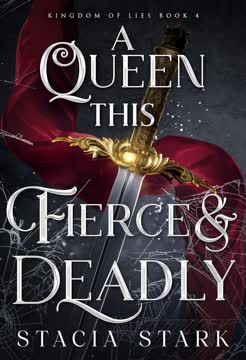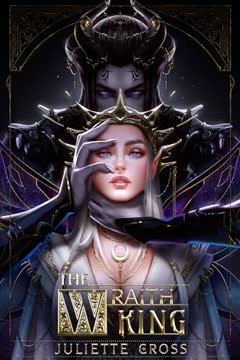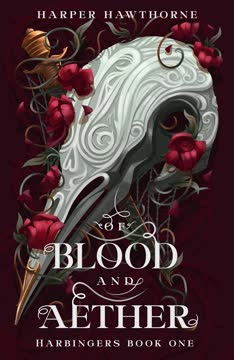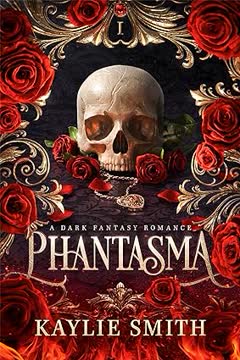Plot Summary
Prologue: Rotting Thrones and Schemes
In the cold halls of Hekkelveld Castle, Astagnon's king is kept alive by dark godkissed magic, his body decaying as priests and the Grand Cleric plot to seize power. The monarchy teeters on the edge, threatened by both internal corruption and the ambitions of the Red Church. The Grand Cleric's machinations set the stage for a kingdom where death is not the end, and the living are pawns in a game of thrones. The prologue's chilling atmosphere foreshadows the coming chaos, as the king's rotting body becomes a symbol of a realm in denial, and the ambitions of men and gods alike begin to stir.
Chains, Coins, and Cheating
Sabine Darrow, a noblewoman with a rare godkissed power to speak to animals, is trapped in Duren, engaged to the cunning Lord Rian Valvere. Her life is a web of debts, bargains, and forced displays—her naked ride across Astagnon a public humiliation. In a high-stakes gambling den, she tries to outwit Rian with a rigged coin toss, hoping to win her freedom. But Rian, ever the master of games, sees through her trick, turning her cleverness into a new form of captivity. Their relationship is a dance of power, seduction, and mutual manipulation, with Sabine's heart still yearning for Wolf Bowborn, the guard who once promised her escape.
The Wolf's Return
Wolf Bowborn, known as Basten, is a man forged by violence and haunted by love. Tasked with interrogating a Volkish raider, he slips back into the brutal role Rian demands of him. Yet beneath the blood and scars, his thoughts are consumed by Sabine. He risks everything to secretly visit her, leaving her a knife for protection. Their connection is raw and forbidden, a dangerous comfort in a world where secrets can kill. Wolf's internal struggle—between the monster he was made to be and the man Sabine sees—sets the emotional stakes for their reunion.
Games of Power and Pain
Sabine, desperate to tame the fae beast (the monoceros) Rian keeps as a weapon, seeks answers in the Valvere library. She's surrounded by locked doors and subtle threats, but finds solace in books and memories of her mother. Her godkissed ability lets her communicate with animals, but the monoceros is a creature of legend, dangerous and untamed. Sabine's attempts to win its trust are slow and fraught, mirroring her struggle to carve out agency in a world that would use her as a pawn. The tension between her compassion and the violence around her grows ever sharper.
Taming Monsters, Taming Hearts
As Sabine's efforts with the monoceros falter, her relationship with Rian grows more complex—he is both captor and reluctant ally. Meanwhile, Wolf's brutal interrogation of the raider uncovers a terrifying truth: Sabine is the lost daughter of King Rachillon of Volkany, the enemy king who seeks to awaken the gods and fae beasts. Wolf kills to protect this secret, even as it drives a wedge between him and Sabine. Their love is a dangerous game, each forced to betray and protect in equal measure, as the threat of war and ancient magic looms.
Lovers in the Shadows
The tension between Sabine and Wolf erupts in a night of passion, their bodies and hearts colliding in a desperate bid for connection. Their love is both sanctuary and sin, a secret that could destroy them. Wolf confesses his inability to love, scarred by his past, while Sabine's longing for more is palpable. Their union is fierce, rough, and tender—a reclamation of power and pleasure in a world that would deny them both. Yet even in their embrace, the specter of betrayal and the weight of their secrets threaten to tear them apart.
The Arena's Bloody Spectacle
Rian stages a brutal spectacle in the arena, forcing Sabine to use her godkissed power to save a child from a tiger, exposing her abilities to the world. The crowd's adoration turns her into a symbol of rebellion, but Rian's manipulation is clear—she is both weapon and bait. Wolf, ever the protector, is caught between his duty and his love, as the lines between ally and enemy blur. The spectacle is a turning point, setting off riots and cementing Sabine's place as both a hero and a target.
The Tiger's Rebellion
Sabine's control over the tiger spirals, her godkissed power pushing her to the brink. The crowd's adulation turns to fear as she nearly loses herself in the animal's rage. Wolf intervenes, grounding her, but the damage is done—her power is no longer a secret, and the Valveres' hold on her tightens. The aftermath is a reckoning: Sabine is locked away, her agency further stripped, while Wolf faces the consequences of his visible devotion. Their love, now public, becomes both shield and sword.
Secrets, Spies, and Scars
As Duren reels from the arena's chaos, Sabine and Wolf navigate a labyrinth of secrets. Sabine uncovers ancient texts hinting at the true nature of the fae and the gods' return. Wolf, battered and hunted, is forced into a deadly bargain with Rian. The city is a powder keg of political intrigue, with the Grand Cleric, the Valveres, and Volkany all vying for power. Sabine's true parentage is a ticking time bomb, and every alliance is fraught with danger. The lines between love, loyalty, and survival blur as the stakes rise.
The Border's Dark Truth
Rian and Wolf journey to the border, uncovering a secret tunnel used by Volkish raiders and discovering a hidden army and fae beasts being awakened. The threat is real and imminent—Volkany is preparing for war, and the gods may soon walk the earth again. Wolf's past as a street fighter and Rian's ambitions collide, their brotherhood tested by old wounds and new betrayals. The journey is a crucible, forging and breaking bonds as the truth of Sabine's heritage and the coming storm become undeniable.
Night in Duren
While Rian and Wolf are away, Sabine escapes her gilded cage for a night in Duren's underbelly. She witnesses the city's love for her, the dangers lurking in the shadows, and the depravity of the Valveres. A chance encounter with her stepmother and father brings old wounds to the surface, while a drunken revelation hints at the letter that changed everything between her and Wolf. The night is a microcosm of Sabine's journey—joy, pain, and the relentless search for truth and belonging.
The Tunnel Beneath the Wall
Wolf and Rian's exploration of the tunnel beneath the border wall reveals the extent of Volkany's preparations: godkissed soldiers, fae beasts, and a king willing to sacrifice anything for power. The discovery of a goldenclaw and the evidence of dark rituals confirm the worst fears. The journey back is fraught with danger, and the knowledge they bring may not be enough to save Astagnon. The cost of magic—both personal and political—becomes ever clearer, as the lines between savior and monster blur.
Revelations and Revelry
As Rian is named successor, the court erupts in celebration and intrigue. Sabine is adorned in chains disguised as finery, her power blocked by Berolt's machinations. The succession is not secure—Berolt's ambitions and the King's Council's duplicity threaten to upend everything. Sabine and Wolf's love is both weapon and weakness, their every move watched and judged. The ball is a stage for both triumph and tragedy, as the true cost of power and freedom is revealed.
The Everlast Approaches
With the Everlast trial looming, Wolf is forced into a fight for his life, while Sabine and her allies plot to tip the scales. The city is on edge, the people hungry for blood and justice. Sabine's power is blocked, her agency stolen, but she finds ways to fight back—through cunning, alliances, and the smallest of creatures. The approach of the Everlast is a drumbeat of dread and hope, as love and survival become inseparable.
The Queen's Chains
As the Everlast begins, Sabine is paraded as a queen-in-waiting, her every move controlled by the Valveres. The necklace that blocks her godkiss is both collar and crown, a symbol of her captivity. Yet even in chains, Sabine finds ways to resist—through small acts of rebellion, secret alliances, and the unwavering love she shares with Wolf. The illusion of power is shattered, revealing the brutal reality beneath the gilded surface.
The Everlast: Blood and Forgiveness
The Everlast is a brutal spectacle, a fight to the death where only one can survive. Wolf, battered and broken, faces godkissed opponents and the ghosts of his past. Sabine, powerless to intervene directly, finds a way to tip the scales with the help of her animal allies. The trial is a crucible of violence and forgiveness, as Wolf's victory is both a personal redemption and a public absolution. Yet the cost is high, and the wounds—physical and emotional—run deep.
Plaguewings and Betrayal
As the city celebrates Wolf's victory, a sudden attack by Volkish raiders and plaguewing starleons turns triumph to tragedy. The sky darkens with death, and the true power of the enemy is revealed. Sabine's godkiss is blocked, but with the help of her allies, she breaks free and unleashes the monoceros's fey fire, turning the tide. The attack is a harbinger of the gods' return, and the cost is measured in thousands of lives. Betrayal and sacrifice become the currency of survival.
The Monoceros Unleashed
Riding the monoceros, Sabine becomes a force of nature, her power both awe-inspiring and terrifying. The fey fire decimates the enemy, but the victory is bittersweet—Duren is left in ruins, and the threat of Volkany and the gods remains. Sabine's exhaustion and trauma are palpable, her connection to Wolf the only anchor in a world turned upside down. The unleashed power is both salvation and curse, a reminder that victory always comes at a price.
The King's Death and the Succession
With Berolt dead and Rian poised to take the throne, the court is a nest of secrets and shifting loyalties. The bloodtaster's test reveals a deeper truth: Wolf is the true heir, switched at birth to protect him from Berolt's cruelty. Rian, faced with the choice between crown and love, bargains for Sabine's freedom in exchange for Wolf's silence. The succession is secured, but the cost is the end of old bonds and the beginning of new ones.
The True Heir's Bargain
Wolf and Sabine are finally free—of Rian, of the Valveres, of the chains that bound them. Their love, hard-won and tested by fire, is now their own. The world is still dangerous, the threat of Rachillon and the gods ever-present, but for the first time, they have hope. The true heir's bargain is not for power, but for love—a choice that redefines what it means to rule and to be free.
The End of Chains
Wolf and Sabine claim their freedom in the forest, exchanging vows and casting off the last of their chains. Their happiness is hard-won, a brief moment of peace in a world still haunted by danger. But as they celebrate their love, the arrival of Immortal Iyre, the fae goddess, shatters their idyll. Sabine is taken through a portal to Volkany, her memory of Wolf intact, but his of her erased. The story ends on a knife's edge—love lost, the gods awakened, and the promise of a new war to come.
The Fae's Arrival
The final chapter is a collision of mortal and immortal, love and loss. Immortal Iyre, awakened by Rachillon, arrives to claim Sabine for the coming war. Wolf, stripped of his memories, is left bereft, haunted by the sense of a love he cannot name. Sabine, taken to Volkany, faces an uncertain future as the gods return and the world is remade. The story ends with a promise: the battle for love, freedom, and the fate of the world is only beginning.
Characters
Sabine Darrow
Sabine is the heart of the story—a young woman whose rare godkissed power to speak to animals makes her both a prize and a threat. Daughter of a lost queen and the enemy king, she is a living symbol of the old world and the new. Sabine's journey is one of agency: from pawn to player, from captive to queen. Her compassion is her greatest strength and her greatest vulnerability, as she refuses to become the monster her world demands. Her love for Wolf is both sanctuary and rebellion, a force that shapes the fate of kingdoms. Sabine's psychological arc is one of self-acceptance, as she learns to wield her power without losing her soul.
Wolf Bowborn (Basten)
Wolf is a man forged by brutality and longing, a street fighter turned bodyguard whose godkissed senses make him both weapon and outcast. His love for Sabine is the axis of his world, a dangerous, redemptive force that drives him to both violence and tenderness. Wolf's psychological struggle is between the monster he was made to be and the man Sabine sees in him. His journey is one of self-forgiveness and sacrifice, as he gives up power and safety for love. The revelation of his true heritage—heir to the throne—forces him to confront what he truly values, and his ultimate choice is a radical act of love.
Rian Valvere
Rian is the quintessential antihero: a master of games, seduction, and manipulation, yet deeply wounded by his family's cruelty. His relationship with Sabine is a complex web of desire, rivalry, and genuine affection, while his bond with Wolf is that of brothers-turned-rivals. Rian's psychological arc is one of ambition versus love—he wants the throne, but not at the cost of his soul. His willingness to bargain for Sabine's freedom, even at the cost of his own happiness, is both his redemption and his tragedy. Rian is a mirror for the story's themes of power, agency, and the cost of survival.
Lord Berolt Valvere
Berolt is the story's embodiment of patriarchal power—a man who sees people as tools, especially the godkissed. His obsession with Sabine's power and his willingness to experiment on his own children make him a chilling antagonist. Berolt's psychological makeup is that of the abuser: charming when it suits him, but ultimately driven by a need to dominate and possess. His death is both a victory and a warning—the old world's cruelty is not easily vanquished.
Grand Cleric Beneveto
The Grand Cleric is the face of the Red Church's ambition, a man who uses faith as a weapon. His alliance with Volkany and his use of forbidden magic to keep the king alive make him a dangerous player. Psychologically, he is a true believer in his own destiny, willing to sacrifice anything for power. His rivalry with Rian is a battle of wits and wills, and his defeat is a turning point in the struggle for Astagnon's soul.
Myst
Myst, Sabine's horse, is more than an animal—she is a confidante, a symbol of freedom, and a link to Sabine's lost mother. Her ability to communicate with Sabine is both comfort and catalyst, guiding her through moments of doubt and danger. Myst's presence is a reminder of the story's deep connection to nature and the old magic, and her role in the climax is both practical and mythic.
Tòrr (the Monoceros)
Tòrr is the living embodiment of fae power—a creature of legend, feared and coveted by all. His relationship with Sabine is a test of trust and will, a mirror for her own struggle to wield power without becoming a monster. Tòrr's eventual acceptance of Sabine is a moment of transcendence, a union of human and fae that signals the return of magic to the world. Psychologically, he is both beast and teacher, a force that cannot be owned, only respected.
Lady Eleonora Valvere
Lady Eleonora is the keeper of the Valvere family's darkest secrets, a woman who has survived by making impossible choices. Her revelation about Wolf's true heritage is both act of protection and betrayal, and her willingness to do whatever it takes for her family is both admirable and chilling. Psychologically, she is a survivor, hardened by loss and the demands of power.
Ferra Yungblood
Ferra is a godkissed beauty artist whose power to alter appearances makes her both ally and wildcard. She moves between worlds—noble and common, male and female, power and vulnerability. Ferra's friendship with Sabine and her romance with Folke are sources of warmth and humor, but her role as a fixer and spy is crucial to the story's web of intrigue.
King Rachillon
Rachillon is the absent father, the enemy king, and the architect of the gods' return. His obsession with awakening the fae and reclaiming Sabine is both personal and apocalyptic. Psychologically, he is a man driven by prophecy and power, willing to sacrifice anything for his vision. His presence is felt in every shadow, and his eventual intervention is the story's ultimate cliffhanger.
Plot Devices
Dual Narration and Shifting Perspectives
The story is told in alternating chapters from Sabine's and Wolf's perspectives, with occasional interludes from Rian and others. This structure allows for deep psychological insight, unreliable narration, and the slow revelation of secrets. The dual narration heightens tension, as the reader is always aware of what one character knows and the other does not, creating dramatic irony and emotional resonance.
Godkissed Magic and Animal Communication
The godkissed are marked by birth with unique powers, making them both valuable and vulnerable. Sabine's ability to speak to animals is central—her compassion is her strength, but it also makes her a target. The magic system is deeply tied to the story's themes of agency, consent, and the cost of power. The use of animal allies, especially in moments of crisis, is both a plot device and a symbol of Sabine's refusal to become a monster.
Foreshadowing and Prophecy
The story is laced with prophecies, ancient texts, and recurring symbols (the monoceros, the fae, the starleons) that foreshadow the return of magic and the upheaval to come. The prologue's decaying king, the ancient books Sabine finds, and the recurring dreams all point to a world on the brink of transformation. The use of prophecy is both a narrative engine and a commentary on fate versus free will.
Political Intrigue and Betrayal
The story is a tapestry of plots within plots—marriage contracts, succession crises, secret tunnels, and deadly bargains. Every character is both player and pawn, forced to choose between love, loyalty, and ambition. The constant betrayals and shifting allegiances keep the reader off-balance, mirroring the characters' own uncertainty and fear.
The Arena and Public Spectacle
The arena is both literal and metaphorical—a place where power is displayed, tested, and enforced. The Everlast trial, the tiger spectacle, and the final battle are all moments where private pain becomes public performance. The use of spectacle is a commentary on the ways societies use violence to maintain order and distract from deeper injustices.
Memory, Identity, and the Fae
The arrival of Immortal Iyre and the erasure of Wolf's memory is the story's final, devastating twist. Memory is both weapon and shield—Sabine's love survives because she remembers, while Wolf is left bereft. The fae's power to alter reality, to open portals and rewrite the past, is both a plot device and a meditation on the nature of identity and love.
Analysis
Silver Wings Golden Games is a sweeping fantasy romance that interrogates the nature of power, agency, and love in a world on the brink of transformation. At its heart, the novel is about the struggle to claim one's own story in the face of forces—political, magical, and patriarchal—that would reduce individuals to pawns. Sabine's journey from captive to queen is a testament to the power of compassion and the refusal to become a monster, even when violence is the currency of survival. Wolf's arc is one of self-forgiveness and radical love, a rejection of the roles imposed on him by birth and circumstance. The novel's use of dual narration, shifting alliances, and a richly imagined magic system creates a tapestry of tension and emotional depth. The arrival of the fae and the erasure of memory in the final chapters is both a devastating cliffhanger and a commentary on the fragility of identity and the enduring power of love. Ultimately, Silver Wings Golden Games is a story about the cost of freedom, the dangers of unchecked ambition, and the hope that, even in a world of gods and monsters, love can be both shield and sword.
Last updated:
Review Summary
Silver Wings Golden Games receives overwhelmingly positive reviews, with readers praising its captivating romance, intricate world-building, and unexpected plot twists. Many describe it as an improvement over the first book, featuring more political intrigue and character development. The forbidden love between Sabine and Basten is a highlight, with their chemistry and steamy scenes drawing particular praise. Some readers express frustration with the cliffhanger ending, while a few criticize certain character behaviors. Overall, fans eagerly anticipate the third book in the series.
